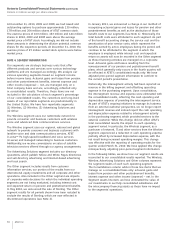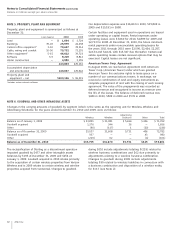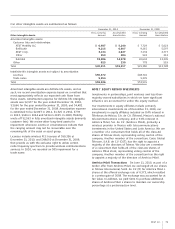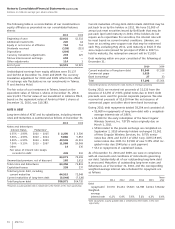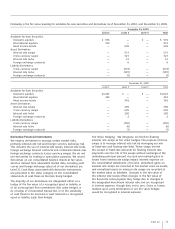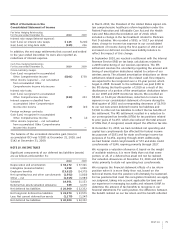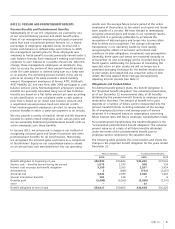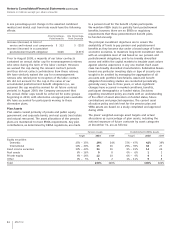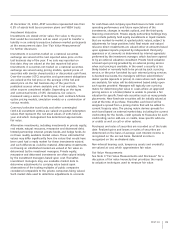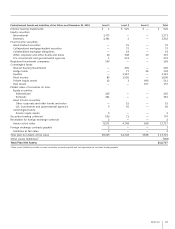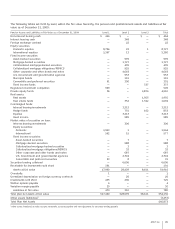AT&T Uverse 2010 Annual Report Download - page 81
Download and view the complete annual report
Please find page 81 of the 2010 AT&T Uverse annual report below. You can navigate through the pages in the report by either clicking on the pages listed below, or by using the keyword search tool below to find specific information within the annual report.
AT&T Inc. 79
In March 2010, the President of the United States signed into
law comprehensive healthcare reform legislation under the
Patient Protection and Affordable Care Act and the Health
Care and Education Reconciliation Act of 2010, which
included a change in the tax treatment related to Medicare
Part D subsidies. We recorded a $995, or $0.17 per diluted
share, charge to income tax expense in our consolidated
statement of income during the first quarter of 2010 and
increased our deferred income taxes liability balance to
reflect the impact of this change.
In September 2010, we reached a settlement with the Internal
Revenue Service (IRS) on tax basis calculations related to
a 2008 restructuring of our wireless operations. The IRS
settlement resolves the uncertainty regarding the amount and
timing of amortization deductions related to certain of our
wireless assets. The allowed amortization deductions on these
settlement-related assets and the related cash flow impacts
are expected to be recognized over a 15-year period, which
began in 2008. Pursuant to the settlement, we paid $300 to
the IRS during the fourth quarter of 2010 as a result of the
disallowance of a portion of the amortization deductions taken
on our 2008 and 2009 income tax returns. We recorded an
$8,300, or $1.40 per diluted share, reduction to income tax
expense in our consolidated statement of income during the
third quarter of 2010 and corresponding decreases of $6,760
to our net noncurrent deferred income tax liabilities and
$1,540 to other net tax liabilities to reflect the tax benefits of
the settlement. The IRS settlement resulted in a reduction to
our unrecognized tax benefits (UTBs) for tax positions related
to prior years of $1,057, which also reduced the total amount
of UTBs that, if recognized, would impact the effective tax rate.
At December 31, 2010, we had combined net operating and
capital loss carryforwards (tax effected) for federal income
tax purposes of $181 and for state and foreign income tax
purposes of $1,052, expiring through 2029. Additionally,
we had federal credit carryforwards of $73 and state credit
carryforwards of $246, expiring primarily through 2027.
We recognize a valuation allowance if, based on the weight
of available evidence, it is more likely than not that some
portion, or all, of a deferred tax asset will not be realized.
Our valuation allowances at December 31, 2010 and 2009,
relate primarily to state net operating loss carryforwards.
We recognize the financial statement effects of a tax return
position when it is more likely than not, based on the
technical merits, that the position will ultimately be sustained.
For tax positions that meet this recognition threshold, we apply
our judgment, taking into account applicable tax laws and
our experience in managing tax audits and relevant GAAP, to
determine the amount of tax benefits to recognize in our
financial statements. For each position, the difference between
the benefit realized on our tax return and the benefit reflected
Effect of Derivatives in the
Consolidated Statement of Income
Fair Value Hedging Relationships
For the year ended December 31, 2010 2009
Interest rate swaps (Interest expense):
Gain (Loss) on interest rate swaps $ 125 $(216)
Gain (Loss) on long-term debt (125) 216
In addition, the net swap settlements that accrued and settled
in the year ended December 31 were also reported as
reductions of interest expense.
Cash Flow Hedging Relationships
For the year ended December 31, 2010 2009
Cross-currency swaps:
Gain (Loss) recognized in accumulated
Other Comprehensive Income $(201) $738
Other income (expense) – net reclassified
from accumulated Other
Comprehensive Income into income — —
Interest rate locks:
Gain (Loss) recognized in accumulated
Other Comprehensive Income (320) 203
Interest expense reclassified from
accumulated Other Comprehensive
Income into income (19) (23)
Foreign exchange contracts:
Gain (Loss) recognized in accumulated
Other Comprehensive Income 5 (2)
Other income (expense) – net reclassified
from accumulated Other Comprehensive
Income into income — —
The balance of the unrealized derivative gain (loss) in
accumulated OCI was $(180) at December 31, 2010, and
$142 at December 31, 2009.
NOTE 10. INCOME TAXES
Significant components of our deferred tax liabilities (assets)
are as follows at December 31:
2010 2009
Depreciation and amortization $ 34,172 $ 37,341
Intangibles (nonamortizable) 1,958 1,990
Employee benefits (13,612) (14,375)
Net operating loss and other carryforwards (1,552) (1,820)
Other – net (1,015) (1,983)
Subtotal 19,951 21,153
Deferred tax assets valuation allowance 949 1,179
Net deferred tax liabilities $ 20,900 $ 22,332
Net long-term deferred tax liabilities $ 22,070 $ 23,579
Less: Net current deferred tax assets (1,170) (1,247)
Net deferred tax liabilities $ 20,900 $ 22,332



